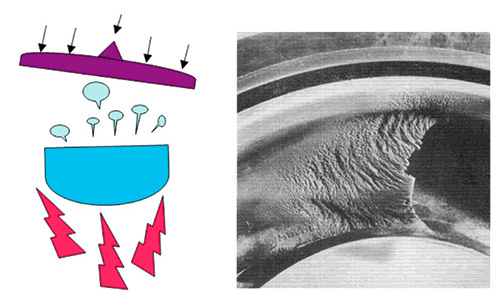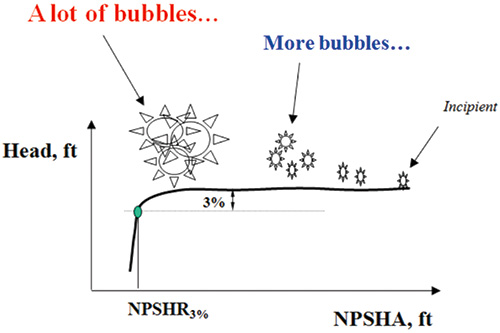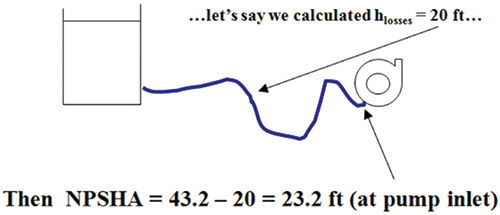07/30/2013
Let’s start with the basics: boiling is the vaporization of liquid. In a kitchen, water boils at high temperature—100 C (212 F). These temperatures are at atmospheric pressure, however.
Liquid can also boil at a cold temperature if its pressure decreases below vapor pressure. If pressure drops, the water will boil at a lower temperature. On top of a high mountain, water boils at perhaps 95 C (203 F). If a low enough vacuum is achieved, water will boil at room temperature.
 Figure 1. Cavitation can cause extreme damage to pumps.
Figure 1. Cavitation can cause extreme damage to pumps.If the pressure reaches a low enough point (below vapor pressure), the liquid will boil. The lowest pressure is usually reached somewhere inside a pump. The lowest pressure zone is most often at the suction area. That is where the first bubbles form. This initial formation is called incipient cavitation, which is closely related to the suction specific speed of a pump. If pressure drops more, more bubbles form. For a while, the pump will continue to operate. If too many bubbles form, they block the suction, and the pump will no longer function. That is when a pump loses its head (see Figure 2). Cavitation can also result in extreme damage to pump casings and impellers.
 Figure 2. Cavitation can cause pumps to lose head and stop operating.
Figure 2. Cavitation can cause pumps to lose head and stop operating.Quiz
Having reviewed these basics, here is a summer quiz. Assume that an open tank filled with cold water is connected to a pump as shown (see Figure 3). This is not an ideal situation because the piping results in hydraulic losses from the tank to the pump’s inlet. The net positive suction head available (NPSHA) would be 43.2 feet, if not for the added piping losses and the 20 feet of additional hydraulic losses.
Some questions need to be examined:
What is a tank water level above the suction connection?
How long is the pipe if it has a 3-inch diameter? How long is the pipe if it has a 12-inch diameter? Note: assume a typical flow through a pump of this size. Keep a practical perspective. Use your experience and judgment when lacking exact data.
In Figure 3, assume that no kinks or turns are present in the piping. Then modify your answer by estimating and adding the pipe losses shown.
 Figure 3. Sample pump operation
Figure 3. Sample pump operationAs always, email your answers for free admission to my next Pump School: www.pumpingmachinery.com/pump_school/pump_school.htm. P&S

